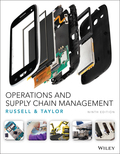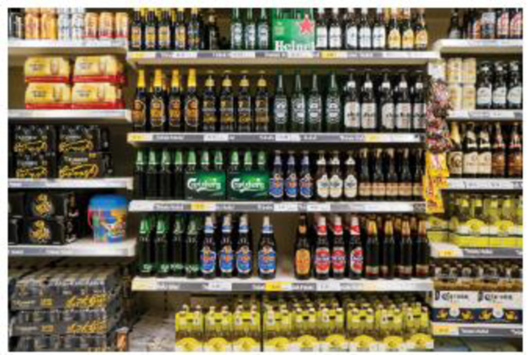
Concept explainers
Supply and Demand in the Spirits Industry
A beverage retailer in the spirits industry often sells products from around the world, each with its own unique supply chain. Beverages for mass consumption (beers and most wines) have a limited shelf life; fine wines and spirits have an extended life but, at a $100 to $3000 per bottle, can tie up needed cash in inventory. Stocking the latest trendy or seasonal beverage can be difficult because of lengthy lead times and the sheer number of SKUs (stock keeping units) available (see photo). A shipment of wine from Argentina, for example, takes an average of 60 days to arrive stateside. Craft beers may be produced in limited quantities and are marketed for specific seasons, so a single order placed a year in advance may be the only opportunity to guarantee supply.
Weight is another problem in the spirits supply chain. A typical 20-foot shipping container packed with bottled product will hit weight restrictions long before reaching FTL (full truck load) by volume. And different countries have different weight restrictions. Several solutions have been proposed. One is transporting mixed loads by partnering with a company whose product follows a similar geographic path but is lightweight. Another is transporting the product in bulk for the longest portion of the trip and bottling it nearer to major markets. Flexible plastic containers (called KN blue tanks) designed to fill a twenty-foot shipping container are more commonly used by producers in Australia and South America. Multiple bottling facilities, however, can add cost, and errors in estimating demand can mean a product needs to be transported further than anticipated to find a receptive market. Finally, the finished product itself can be sold in bags, boxes, or pouches instead of bottles. Astro pouches with colorful designs have become quite popular for some types of alcoholic beverages.
Climate controlled transport is expensive, too, especially for ocean routes; so much so that shippers of wine and beer to northern markets may travel to less accessible warm weather ports and then use heated trucks for transport to final destinations in colder climes. Some companies only ship product during the more temperate months of the year, further restricting supply.
Fine wines present their own special problems. Most wines travel from vineyard to producer to distributor to retailer within a year. However, fine wines may not be ready to drink for 10 years and may have a shelf life of 50 years. Ownership can change many times from production to consumption, and inventory must be carefully stored. Transporting these wines often or over long distances can damage them and expose the owner to fraud and theft. A pallet of Chateau Lafite-Rothschild Bordeaux, for example, may be valued at half a million dollars. So a new industry has emerged that keeps fine wines in climate controlled storage and transfers ownership (in a database), instead of product, when sales are made.

Faiz Zaki/Shutterstock
We often don’t think of transportation as being a major cost of production. Is it appropriate to include the cost of logistics in the retail price of an item? How would you do that? Give an example.
Want to see the full answer?
Check out a sample textbook solution
Chapter 14 Solutions
Operations and Supply Chain Management 9th edition
Additional Business Textbook Solutions
Advanced Financial Accounting
Foundations Of Finance
Financial Accounting: Tools for Business Decision Making, 8th Edition
Operations Management
Corporate Finance (4th Edition) (Pearson Series in Finance) - Standalone book
Auditing And Assurance Services
- Not use ai pleasearrow_forwardWhat is Bitcoin? How important is it to businesses and individuals? How does it cause environmental damage and is that damage worth continued uses of Bitcoin? Read the following articles to help answer these questions: United Nations University. (2023, October 24). UN study reveals the hidden environmental impacts of bitcoin: Carbon is not the only harmful by-product. https://unu.edu/press-release/un-study-reveals-hidden-environmental-impacts-bitcoin-carbon-not-only-harmful-product#:~:text=Bitcoin%2C%20the%20most%20popular%20cryptocurrency,the%20worldwide%20Bitcoin%20mining%20network. Salam, E. (2023, April 26). Bitcoin is terrible for the environment – can it ever go green? The Guardian. https://www.theguardian.com/technology/2023/apr/26/bitcoin-mining-climate-crisis-environmental-impactarrow_forward419 X .com/courses/1546/assignments/49499?module_item_id=111573 Unlimited Attempts Allowed ✓ Details Directions: Record a video of yourself giving a business presentation. Imagine you are tasked with researching a professional development topic on business communication for 40 coworkers. You are then expected to give a 4 - 5 minute presentation on the topic. Choose any topic related to business communication, such as intercultural communication, effective leadership, professional writing, etc. Research the topic and prepare a 4 - 5 minute presentation that could be given over video conference call (such as Zoom). You may use visual aids if you choose. Upload a video file of your presentation. Provide all needed citations. Requirements: 4-5 minutes long Contains visual and audio Create your own work; do not plagiarize Cite your sources using APA citations Choose a submission type Tarrow_forward
- acts Container chips (s 150 cussion: Conflict X + e.com/courses/1546/discussion_topics/15722?module_item_id=111559 24 Winter > Discussions > Week 8 Discussion: Conflict 时☆ 26 Replies, 26 Unread Week 8 Discussion: Conflict Write a 200 - 300 word discussion post based on the prompt below. Reply to at least one other student in 50 - 100 words. Can you think of a time when a conflict led to a new opportunity, better understanding, or other positive result? If not, think of a past conflict and imagine a positive outcome. Discuss the impact of this conflict on your workplace relationships, productivity, and innovation. Source: Business Communication for Success. (2015). University of Minnesota Libraries Publishing. Attribution-NonCommerical-ShareAlike. Edit View Insert Format Tools Table 12ptv Paragraph BIUA T2arrow_forwardHow would you design and implement a modern networking solution for JAMS Manufacturing to connect all their facilities and ensure seamless communication? The company currently has standalone systems in three manufacturing plants and an office building, each using its own modem or router for internet access. The goal is to create private networks for each location, connect them to one another, and provide Internet access to all. You’ll need to consider factors like new computer systems, servers, and telecommunications wiring, and explain how your solution will benefit the company and how it will be implemented effectively.arrow_forwardIdentify specific performance management processes covered in this course and how each aligns with an elements of LaFevor’s HCMS Model.arrow_forward
- Identify specific performance management processes covered in this course and how each aligns with LaFevor’s HCMS Model. LaFevor, K. (2017). What’s in Your Human Capital Management Strategy? The Game Plan, the Path, and Achievingarrow_forwardassess how Human Capital Management Strategy is aimed at building an effective integrated performance management system: Discuss how human capital management strategy relates to performance management.arrow_forwardCASE STUDY 9-1 Was Robert Eaton a Good Performance Management Leader? R obert Eaton was CEO and chairman of Chrys- ler from 1993 to 1998, replacing Lee Iacocca, who retired after serving in this capacity since 1978. Eaton then served as cochairman of the newly merged DaimlerChrysler organization from 1998 to 2000. In fact, Eaton was responsible for the sale of Chrysler Corporation to Daimler-Benz, thereby creating DaimlerChrysler. With 362,100 employees, DaimlerChrysler had achieved revenues of €136.4 billion in 2003. DaimlerChrysler's passenger car brands included Maybach, Mercedes-Benz, Chrysler, Jeep, Dodge, and Smart. Commercial vehicle brands included Mercedes-Benz, Freightliner, Sterling, Western Star, and Setra. From the beginning of his tenure as CEO, Eaton communicated with the people under him. He immediately shared his plans for the future with his top four executives, and upon the advice of his colleague, Bob Lutz, decided to look around the company before making any hasty…arrow_forward
- Critically assess Martin’s coaching style.arrow_forwardCompare Robert Eaton’s performance management leadership presented in the case against the performance management leadership principles, functions, and behaviors. What recommendations can be made about what he might do more effectively? Explain and defend your answer.arrow_forwardIn the context of the material in Chapter 9, provide a critical analysis of the decisions that Henry has made in assigning Martin to this role.arrow_forward
 Purchasing and Supply Chain ManagementOperations ManagementISBN:9781285869681Author:Robert M. Monczka, Robert B. Handfield, Larry C. Giunipero, James L. PattersonPublisher:Cengage Learning
Purchasing and Supply Chain ManagementOperations ManagementISBN:9781285869681Author:Robert M. Monczka, Robert B. Handfield, Larry C. Giunipero, James L. PattersonPublisher:Cengage Learning Contemporary MarketingMarketingISBN:9780357033777Author:Louis E. Boone, David L. KurtzPublisher:Cengage Learning
Contemporary MarketingMarketingISBN:9780357033777Author:Louis E. Boone, David L. KurtzPublisher:Cengage Learning Practical Management ScienceOperations ManagementISBN:9781337406659Author:WINSTON, Wayne L.Publisher:Cengage,MarketingMarketingISBN:9780357033791Author:Pride, William MPublisher:South Western Educational Publishing
Practical Management ScienceOperations ManagementISBN:9781337406659Author:WINSTON, Wayne L.Publisher:Cengage,MarketingMarketingISBN:9780357033791Author:Pride, William MPublisher:South Western Educational Publishing




